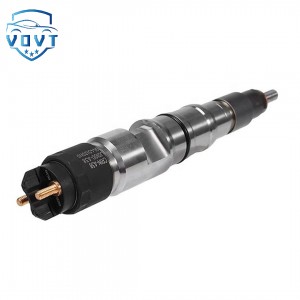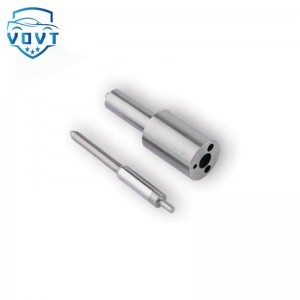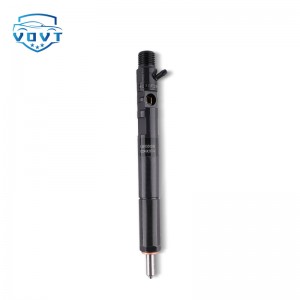Genuine Quality Diesel Fuel Injector Nozzle 0433171583 0 433 171 583 Fuel Nozzle DLLA154P866 Engine Elements
Products Description
| Reference. Codes | DLLA154P866 |
| Application | / |
| MOQ | 12PCS |
| Certification | ISO9001 |
| Place of Origin | China |
| Packaging | Neutral packing |
| Quality Control | 100% tested before shipment |
| Lead time | 7~15 working days |
| Payment | T/T, L/C, Paypal, Western Union, MoneyGram or as your requirement |
Anatomy of the structural characteristics of diesel injector nozzles
In the complex fuel injection system of a diesel engine, the injector nozzle is as crucial as the heart. Its delicate structure not only determines the accuracy of fuel injection, but is also closely related to engine power, fuel consumption, emissions and other performance indicators. In-depth investigation of the nozzle structure characteristics is a must to unlock the code of efficient operation of diesel engines.
Main structure analysis
(i) Needle valve assembly
Needle valve as a “valve” to control fuel injection, the head is cone-shaped, and the valve body seat surface precision grinding with excellent sealing performance, can effectively block the fuel non-injection time leakage. The needle valve stem is slender and smooth, sliding in the guide hole of the valve body, and its high-precision dimensional tolerance ensures smooth movement, which can quickly and accurately open or close the injection holes in response to engine control commands, so that the timing of fuel injection is not inaccurate.
(ii) Valve body structure
The valve body is the skeleton of the fuel nozzle shell, made of high-strength alloy, with good rigidity to withstand the high temperature and high pressure impact transmitted by the combustion chamber. Its internal design has complex fuel channels, which are polished by a special process to ensure uniform fuel flow and no turbulence, providing a stable fuel pressure environment for the needle valve, so that the injection volume can be precisely regulated under different working conditions.
(iii) Layout of injection holes
The injection hole is the outlet of fuel atomization, and its hole diameter, number and distribution are unique. Small diesel engines for the pursuit of fine fuel control, injection holes are usually tiny, at the micron level, the number of smaller, symmetrical distribution, to ensure that the fuel is sprayed into the combustion chamber as a fine mist, to achieve efficient combustion. Large diesel engines due to high fuel demand, the injection hole diameter is slightly larger, the number increases, and according to the shape of the combustion chamber using an asymmetric layout, to ensure that the fuel comprehensive coverage of the combustion space, to avoid uneven local combustion.
(iv) Spring system
The spring plays a key role in the nozzle, providing reset force for the needle valve. The selected spring material has high elastic limit and fatigue strength, and can maintain stable elasticity during long-term high-frequency compression and diastolic cycles. Its elasticity coefficient is strictly adjusted and optimized according to the engine operating speed and load range, which helps the needle valve to precisely micro-control fuel injection at idle speed and ensures the needle valve to close reliably under high load to prevent fuel leakage.
Adaptation of Material Characteristics
The fuel nozzle as a whole adopts special alloy steel, such as nickel-based alloy, which is resistant to high temperature, abrasion and corrosion. On the side of the combustion chamber, in the face of thousands of degrees Celsius high-temperature gas scouring, the surface of the material to form a dense oxidized film, preventing further erosion; and the fuel contact part of the fuel chemical corrosion resistance, to maintain structural integrity. Some high-end nozzles also use ceramic coating to strengthen the key parts, the use of ceramic high hardness, low coefficient of friction characteristics, to reduce the wear of the needle valve movement, to extend the service life.
Structure and Performance
Precise needle valve body coordination to ensure fuel quantitative injection, to avoid fluctuations in engine power; reasonable injection hole design to optimize fuel atomization, improve combustion efficiency, reduce fuel consumption and emissions; adaptive spring system to ensure that the dynamic response of the nozzle in a timely manner to adapt to the engine complex operating conditions switching. The synergistic operation of each structure makes the diesel engine achieve an ideal balance in power, economy and environmental protection.
Diesel injector nozzle structure is precise and complex, from the core components to the choice of materials, all of which contain deep technical heritage. A deep understanding of the structural characteristics of the fuel injector nozzle is essential for the continuous improvement of the nozzle design and the enhancement of the performance of diesel engines. With the development of science and technology, this key component will surely move towards a higher level of performance and promote the development of the diesel power field.























